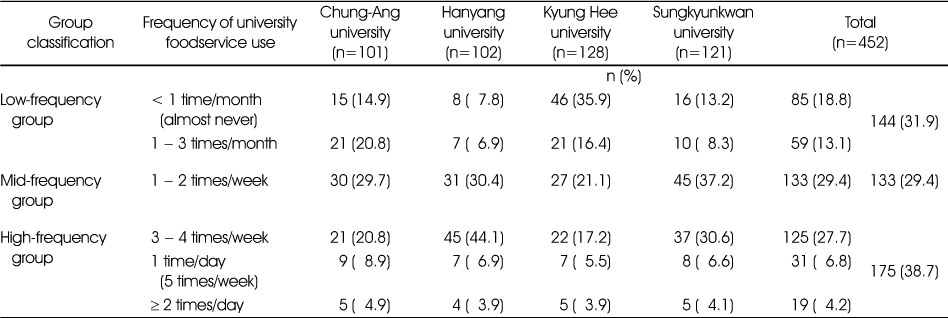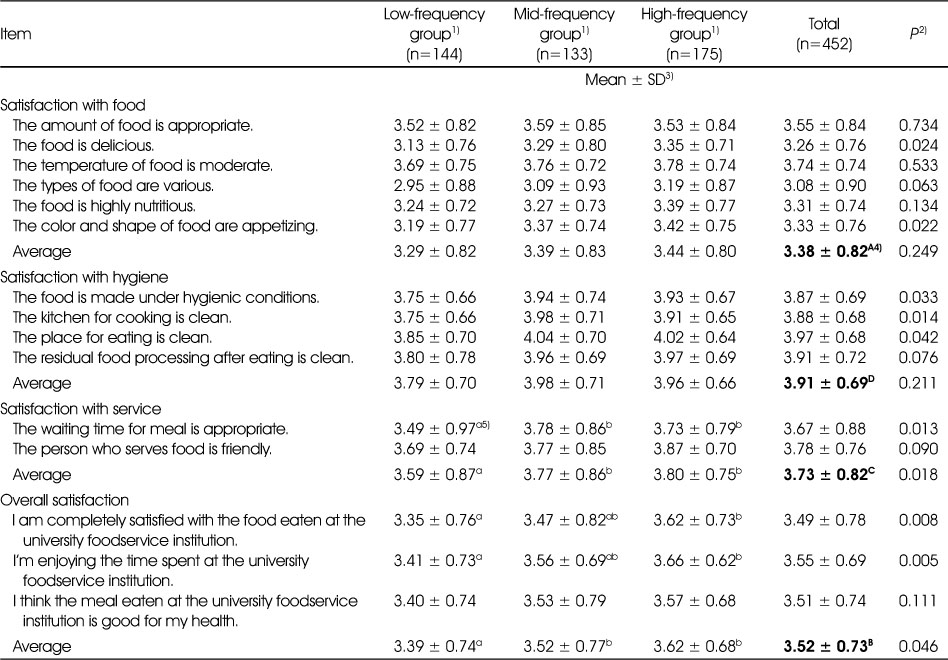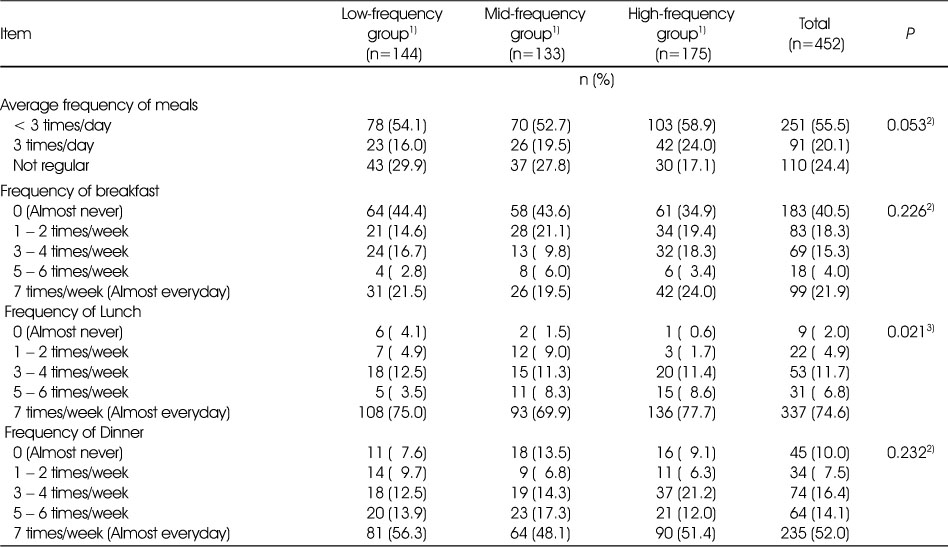Articles
- Page Path
- HOME > Korean J Community Nutr > Volume 25(4); 2020 > Article
- Research Article
- Dietary Life of Chinese International Students according to the Frequency of University Foodservice Use in Korea
- Yan Cui, Hye-Jong Yoo, Injoo Choi, Jihyun Yoon
-
Korean Journal of Community Nutrition 2020;25(4):291-302.
DOI: https://doi.org/10.5720/kjcn.2020.25.4.291
Published online: August 31, 2020

2Instructor, Department of Food and Nutrition, College of Human Ecology, Seoul National University, Seoul, Korea

3Professor, Department of Food and Nutrition, College of Human Ecology, Seoul National University, Seoul, Korea

-
Corresponding author:
Jihyun Yoon,
Email: hoonyoon@snu.ac.kr
- 773 Views
- 5 Download
- 1 Crossref
- 0 Scopus
Abstract
Objective
This study investigated the current use of university foodservice among Chinese international students in Korea, focusing on the relationship between the frequency of university foodservice use and their dietary life.
Methods
An online survey was conducted on 452 Chinese international students from February 6 to 12, 2020. The respondents were classified into “the Low-frequency group” (< one time/week; n=144), “the Mid-frequency group” (one-two times/week; n=133), and “the High-frequency group” (≥three times/week; n=175) according to their frequency of using university foodservice. The dietary life was compared among the three groups.
Binominal logistic regression models were constructed to determine the associations between the frequency of university foodservice use and the changes in dietary life.
Results
More than 2/3 (68.1%) of the respondents used the university foodservice at least once per week. Chinese international students who were males and Han Chinese people, lived on campus, had stayed longer in Korea, and had no cooking facilities tended to use the university foodservice more often. The level of satisfaction with the university foodservice was not high (3.52 out of 5-points). Only 20% ate meals three times per day, and only 22% ate breakfast almost every day. The frequencies of overeating and skipping meals increased after studying in Korea. The frequency of university foodservice use, along with the length of residence in Korea, was associated with these negative changes in dietary life. Overeating (OR=2.11) and skipping meals (OR=1.79) were more likely to increase after studying in Korea in the Mid-frequency group than in the High-frequency group.
Conclusions
The frequency of university foodservice use was associated with the dietary life of Chinese international students in Korea. A high frequency (i.e. ≥three times/week) of using university foodservice may positively affect the dietary life of Chinese international students in Korea.
Published online Aug 31, 2020.
https://doi.org/10.5720/kjcn.2020.25.4.291
Dietary Life of Chinese International Students according to the Frequency of University Foodservice Use in Korea
Abstract
Objectives
This study investigated the current use of university foodservice among Chinese international students in Korea, focusing on the relationship between the frequency of university foodservice use and their dietary life.
Methods
An online survey was conducted on 452 Chinese international students from February 6 to 12, 2020. The respondents were classified into “the Low-frequency group” (< one time/week; n=144), “the Mid-frequency group” (one-two times/week; n=133), and “the High-frequency group” (≥ three times/week; n=175) according to their frequency of using university foodservice. The dietary life was compared among the three groups. Binominal logistic regression models were constructed to determine the associations between the frequency of university foodservice use and the changes in dietary life.
Results
More than 2/3 (68.1%) of the respondents used the university foodservice at least once per week. Chinese international students who were males and Han Chinese people, lived on campus, had stayed longer in Korea, and had no cooking facilities tended to use the university foodservice more often. The level of satisfaction with the university foodservice was not high (3.52 out of 5-points). Only 20% ate meals three times per day, and only 22% ate breakfast almost every day. The frequencies of overeating and skipping meals increased after studying in Korea. The frequency of university foodservice use, along with the length of residence in Korea, was associated with these negative changes in dietary life. Overeating (OR=2.11) and skipping meals (OR=1.79) were more likely to increase after studying in Korea in the Mid-frequency group than in the High-frequency group.
Conclusions
The frequency of university foodservice use was associated with the dietary life of Chinese international students in Korea. A high frequency (i.e. ≥ three times/week) of using university foodservice may positively affect the dietary life of Chinese international students in Korea.
Table 1
Frequency of university foodservice use among Chinese international students in Korea
Table 2
General characteristics of the respondents according to the frequency of university foodservice use
Table 3
Level of satisfaction with university foodservice among Chinese international students in Korea according to the frequency of university foodservice use
Table 4
Frequency of meals among Chinese international students in Korea according to the frequency of university foodservice use
Table 5
Changes in dietary life after studying in Korea among Chinese international students according to the frequency of university
foodservice use
Table 6
Factors related to the changes in dietary life after studying in Korea among Chinese international students
Acknowledgments
This work was supported by The Research Institute of Human Ecology, Seoul National University.
References
-
Ministry of Education. Statistics of foreign students at higher education institutions in Korea in 2019 [internet]. Ministry of Education; 2019 [cited 2020 Mar 4].Available from: https://www.moe.go.kr/.
-
-
Sim MK, Han DH, Park CB. A study of foreign students’ perceptions toward their lived experience in Korean university residence hall. Multicult Educ Stud 2015;8(4):137–159.
-
-
Yonhap News. Hanyang University hallal restaurant opened unique...Muslim students welcome [internet]. 2013 [updated 2013 Mar 7]. [cited 2020 Jul 3].Available from: https://news.naver.com/main/read.nhn?mode=LSD&mid=sec&sid1=102&oid=001&aid=0006133244.
-
-
Cornell University. Options for dining on campus [internet]. 2019 [updated 2019 Jan 1]. [cited 2019 Apr 6].
-
-
Hong KH, Lee HS. Study of the dietary behaviors and adaptation for Korean foods among international students in Busan. J Korean Soc Food Cult 2018;33(2):112–124.
-
-
Gao W, Kim SY, Chang NS, Kim KN. Dietary behavior and nutritional status among Chinese female college students residing in Korea. Korean J Nutr 2013;46(2):177–185.
-
-
Jung HY, Jeon ER. Preference for Korean food and satisfaction of dormitory foodservice by Chinese students studying at Mokpo National University. J Korean Soc Food Sci Nutr 2011;40(2):283–289.
-
-
Fan MM, Bae HJ. Analyzing the importance and satisfaction on the university foodservice selection attributes of foreign Chinese students in Gyeongbuk province. Korean J Food Nutr 2014;27(1):128–135.
-
-
Ryu SH, Cho YH, Han YR. Adaptation for Korean foods and satisfaction for foodservice by different residence periods of Chinese and Japanese university students in Daejeon. J East Asian Soc Dietary Life 2014;24(1):143–155.
-
-
Yi NY. Mediating effects of perceived value on the relationship between university foodservice quality attributes and satisfaction of Chinese students in Daejeon. J Korean Soc Food Sci Nutr 2015;44(11):1750–1758.
-
-
Hong KH, Lee HS. An evaluation on the attitudes and importance-satisfaction on service quality of university foodservice among international students in Busan. Korean J Community Nutr 2019;24(3):208–222.
-
-
Liu HN, Jang JS. A study on the dietary habits, life habits, drink preference and intake according to the Chinese students gender in Gyeonggi province. Korean J Food Nutr 2018;31(2):293–300.
-
-
Song FF, Kim MJ. Acculturation, food intake and dietary behaviors of Chinese college students in Busan by residential period. J East Asian Soc Dietary Life 2015;25(4):594–606.
-
-
Wang JS, Kang YE, Lee SY. Stress and dietary behavior by acculturation level among Chinese students living in Korea. J East Asian Soc Diet Life 2019;29(1):42–55.
-
-
Gao RR, Kim JH. Changes in dietary life and health-related lifestyle by stress level in Chinese international students in Korea. J Korean Diet Assoc 2018;24(1):75–91.
-
-
Ministry of Education. Statistics of foreign students at higher education institutions in Korea in 2018 [internet]. Ministry of Education; 2018 [cited 2019 Mar 12].Available from: https://www.moe.go.kr/.
-
-
Yoon JH, Kwon SY, Kim OS, Ryu SH, Lee YM, Han GS, et al. In: Quantity food production and service management. Goyang: Powerbook; 2019. pp. 52-58.
-
-
Lee KA, Lyu ES. Importance-Performance Analysis (IPA) of service quality attributes of university foodservice by city size. Korean J Food Cook Sci 2017;33(6):691–701.
-
-
Lyu ES, Lee KA. Perception of foodservice quality according to the customer loyalty among university students in Daegu· Gyeongbuk area. Korean J Food Cook Sci 2018;34(1):113–123.
-
-
Zhou YM. Investigation report on the satisfaction of dining in college canteen. Manag Technol SME 2018;3:108–109.
-
-
Lee KA, Lyu ES. Importance-Performance Analysis (IPA) of university foodservice quality by customer group according to the foodservice satisfaction and customer loyalty. J Korean Soc Food Sci Nutr 2019;48(1):109–119.
-
-
Min KJ, Choi IS. Studies on dietary habits and residence students' satisfaction with university dormitory foodservice in Jeollabuk-do Iksan area. J Korean Soc Food Cult 2016;31(5):442–456.
-
-
Lee KA, Park SY, Lyu ES. Relationship between foodservice satisfaction and customer loyalty of university dormitory foodservice in Gyeongsangbuk-do area. J Korean Soc Food Sci Nutr 2017;46(2):259–266.
-
-
Kim DM, Kim YR, Kim KH. Dietary habits and nutritional status of young women according to breakfast frequency in Seoul. Korean J Community Nutr 2018;23(2):102–115.
-
-
Kim TH, Han TY, Choi YC. Correlation between breakfast skipping and body composition in college students. The Korea J Sports Sci 2019;28(5):1085–1093.
-
-
Wang YL, Wang ZX. The survey on the nutrition of diet and the health of college student. Farm Prod Process 2015;378:63–66.
-
-
China Youth. Chinese college students' frequency of eating breakfast [internet]. 2019 [updated 2019 Oct 11]. [cited 2020 Jun 28].Available from: http://edu.youth.cn/jyzx/jyxw/201910/t20191011_
12090917.htm.
-
-
Xi MZ. In: Changes in dietary habits and food intake frequency among Chinese students in Korea [master's thesis]. Chung-Ang University; 2017.
-
-
Li GT. In: The change of dietary environment and snacking habits of Chinese students in South Korea [master's thesis]. Gachon University; 2013.
-
-
Shim MK, Han DH, Park CB. A study of foreign students' perceptions toward their lived experience in Korean university residence hall. Multicult Educ Stud 2015;8(4):137–159.
-
-
Cho JH. Effects of service quality on customer's perceived value, customer satisfaction, trust, and behavioral intention in the university cafeteria. J Korea Serv Manag Soc 2015;16(5):73–100.
-

 KSCN
KSCN







 Cite
Cite


